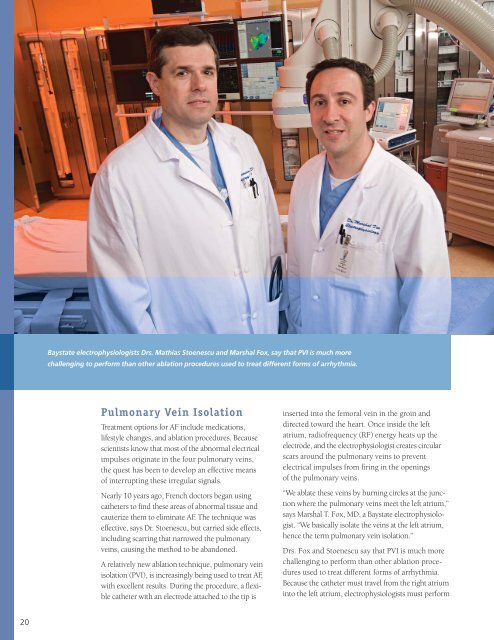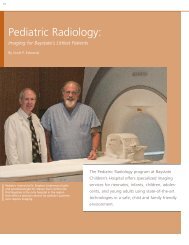Read it in pdf format - Baystate Health
Read it in pdf format - Baystate Health
Read it in pdf format - Baystate Health
You also want an ePaper? Increase the reach of your titles
YUMPU automatically turns print PDFs into web optimized ePapers that Google loves.
<strong>Baystate</strong> electrophysiologists Drs. Mathias Stoenescu and Marshal Fox, say that PVI is much more<br />
challeng<strong>in</strong>g to perform than other ablation procedures used to treat different forms of arrhythmia.<br />
Pulmonary Ve<strong>in</strong> Isolation<br />
Treatment options for AF <strong>in</strong>clude medications,<br />
lifestyle changes, and ablation procedures. Because<br />
scientists know that most of the abnormal electrical<br />
impulses orig<strong>in</strong>ate <strong>in</strong> the four pulmonary ve<strong>in</strong>s,<br />
the quest has been to develop an effective means<br />
of <strong>in</strong>terrupt<strong>in</strong>g these irregular signals.<br />
Nearly 10 years ago, French doctors began us<strong>in</strong>g<br />
catheters to f<strong>in</strong>d these areas of abnormal tissue and<br />
cauterize them to elim<strong>in</strong>ate AF. The technique was<br />
effective, says Dr. Stoenescu, but carried side effects,<br />
<strong>in</strong>clud<strong>in</strong>g scarr<strong>in</strong>g that narrowed the pulmonary<br />
ve<strong>in</strong>s, caus<strong>in</strong>g the method to be abandoned.<br />
A relatively new ablation technique, pulmonary ve<strong>in</strong><br />
isolation (PVI), is <strong>in</strong>creas<strong>in</strong>gly be<strong>in</strong>g used to treat AF,<br />
w<strong>it</strong>h excellent results. Dur<strong>in</strong>g the procedure, a flexible<br />
catheter w<strong>it</strong>h an electrode attached to the tip is<br />
<strong>in</strong>serted <strong>in</strong>to the femoral ve<strong>in</strong> <strong>in</strong> the gro<strong>in</strong> and<br />
directed toward the heart. Once <strong>in</strong>side the left<br />
atrium, radiofrequency (RF) energy heats up the<br />
electrode, and the electrophysiologist creates circular<br />
scars around the pulmonary ve<strong>in</strong>s to prevent<br />
electrical impulses from fir<strong>in</strong>g <strong>in</strong> the open<strong>in</strong>gs<br />
of the pulmonary ve<strong>in</strong>s.<br />
“We ablate these ve<strong>in</strong>s by burn<strong>in</strong>g circles at the junction<br />
where the pulmonary ve<strong>in</strong>s meet the left atrium,”<br />
says Marshal T. Fox, MD, a <strong>Baystate</strong> electrophysiologist.<br />
“We basically isolate the ve<strong>in</strong>s at the left atrium,<br />
hence the term pulmonary ve<strong>in</strong> isolation.”<br />
Drs. Fox and Stoenescu say that PVI is much more<br />
challeng<strong>in</strong>g to perform than other ablation procedures<br />
used to treat different forms of arrhythmia.<br />
Because the catheter must travel from the right atrium<br />
<strong>in</strong>to the left atrium, electrophysiologists must perform<br />
20

















